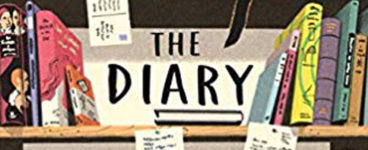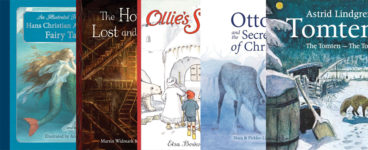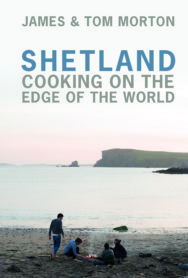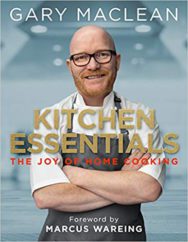‘More stovies because stovies are wonderful. And the reason stovies were so much a part of Yule is because they are made from leftovers. Imagine all the aspects of a roast dinner, chopped and mushed together with gravy. Astounding.’
Gorgeous cookbooks are always a mainstay on Christmas and bestseller lists. Father and son, Tom and James Morton have given us a tribute Shetland life that will make your mouth water and have you booking a trip there for the new year. Here is their perfect recipe for your Christmas leftovers.
Shetland: Cooking at the Edge of the World
By Tom & James Morton
Published by Quadrille
Shetland didn’t really have Christmas until Christianity came calling in the middle of the last millennium, initially in the form of strange, clifftop monastic communities from Ireland. When it took root, Christmas grew in the fertile soil of Yule or Jöl.
And now we get to the trows or trowies – a word derived from the Scandinavian Troll. Their legend is intertwined with Yule. There are all kinds of abstruse academic discussions in Shetland as to who the trowies were or who they represent – some say they were the remnants of the Pictish inhabitants of the soaring brochs: the stone-built structures that remain best preserved in Shetland.
To me, the trows signify some of the darkest fears of a small rural community. The child-stealer. The thief. The kidnapper and the husbandgrabber. The dreadful monster from the sea that lurks in the dark and will destroy you and all you love. Best guard against the trows. And, if you happen to be seduced by their music and end up in their hollow mound or cave, never, ever eat their food. Or they will have you forever.
Seven days before Yule Day, legend says that trows had permission to live above ground. Various precautions were taken. Two straws were formed into a cross and laid at the entrance to the yard where the corn and hay were stored. Animal hair was pleated and pinned over the door to the byre. And a blazing peat was carried through all the outhouses.
A day later it was Helya’s Nicht, another occasion for milgruel. Then came Tammasmas Nicht. No work was done after twilight on Tammasmas and breaking that rule was bound to bring bad luck:
The very babe unborn cries, “Oh dül, dül”, ( ‘dül’ – sorrow.)
For the brakkin o” Tammasmas Nicht
Five nichts afore Yule.
The Sunday before Yule was Byaena’s Day, and it was time for the head of an ox or cow. Substituting a sheep’s head was permissible. Once the fat and meat from the head was used, the skull was thoroughly cleaned and a candle placed in the eye-socket, ready for Yule morning. This was considered both acceptable and indeed, welcome.
On Yule Eve, even the poorest family would eat meat. There was ritual washing: three pieces of red-hot peat were dropped into the water when hands or feet were washed, or the trows would paralyse them. People put on clean clothes, cleaned the house and hid away anything considered unholy. All doors were left unlocked with a lamp lit and a piece of iron near the door.
For Yule dawn, the candle in the cow’s skull was lit and carried through the house and adjoining barn, where the animals were especially well fed.
There was a morning glass of spirit – sometimes home-distilled, sometimes imported rum – and breakfast was taken. Yule cakes (more scalloped bannocks) were made to resemble and symbolise the lost sun. From then, meat was key. Salted, smoked fresh mutton, beef – no dirty pork – along with salt or dried fish. Vivda (dried meat). Some even had wild ducks, captured in early December and fattened in cages. Oh, and stovies.
Once the animals were fed, Yule Day was a day of rest, although as the short day passed and night fell in the town of Lerwick, bored young men’s thoughts turned to dangerous pastimes. Namely, lighting tar-filled barrels on fire. This practice morphed into the festival of Up Helly Aa, which was once the name for the twenty-fourth night of Yule. Fire always played a part – it signified the lightening of the coming days and scared away those pesky trows.
Our Christmas
I love Christmas, and I love it for the way it brings light to the darkness. It’s all about being together, at home. Has my entire extant family ever been at home together at Christmas? Not yet. But a large chunk of them regularly do trek to Shetland, amid the extreme weather, the cold, the darkness and the risk of trow attack. And there is fire and warmth from the Rayburn and the well-oiled central heating. There is good food, fine wine, and the best whisky I can afford.
We watch TV. We squabble and fight and laugh. We even go to church, for that once-a-year visit to the disused otherwise Hillswick Kirk. Candles flicker in its cavernous interior, which smells of damp. We sit and remember other Christmases, those that are lost to us. We sing hymns, badly, and listen to a sermon nobody remembers. And I think of that one magical year when we went into the Kirk in hard, blustery frost, and emerged into the calm, muffled silence of heavy snow, falling, covering our sins like forgiveness. We took off our gloves and shook hands and smiled.
Leftover stovies
2 large onions
2 tbsp dripping from your roast (lard will do)
1kg (2lb 4oz) potatoes, peeled and sliced
500ml (2 cups) leftover gravy or meat juices (or stock)
500g (1lb 2oz) leftover cooked meat, cut into 2–3cm (1 inch) chunks
good sea salt
freshly ground black pepper
More stovies because stovies are wonderful. And the reason stovies were so much a part of Yule is because they are made from leftovers. Imagine all the aspects of a roast dinner, chopped and mushed together with gravy. Astounding.
Cooked meat is an essential.
Slice your onions as finely as you can be bothered. Chuck them into a large, heavy-bottomed pan with a lid, together with the dripping, and stick it on a medium heat. Fry until soft.
Slice your potatoes thinly – this can take a wee while. Layer them all over the fried onions and pour in your gravy. Add the meat, then top up with enough water or stock to cover.
Stick the lid on and bring to a boil. Then, once boiling vigorously, turn down to a low heat so that it barely simmers.
Cook for about half an hour, stirring occasionally. Check regularly and keep cooking until the potatoes start to fall apart – this is proper comfort food. Taste, and be ready to add a good bit of salt and a healthy dose of pepper for that background bit of Scottish spice.
Shetland: Cooking at the Edge of the World by Tom & James Morton is published by Quadrille, priced £25.00
Another Christmas recommendation: Gary Maclean’s Kitchen Essentials, published by Black and White, priced £20.00
ALSO IN THIS ISSUE

 Christmas in the Bookshop
Christmas in the Bookshop
‘Shortly before closing time on Christmas Eve there is, without fail, a surge of panicked farmers de …

 Merry Christmas from Floris Books!
Merry Christmas from Floris Books!
‘It’s a cold winter’s night and a hungry fox is creeping through the snow.’














